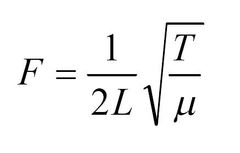![]()
![]()
![]()
Use LEFT and RIGHT arrow keys to navigate between flashcards;
Use UP and DOWN arrow keys to flip the card;
H to show hint;
A reads text to speech;
20 Cards in this Set
- Front
- Back
|
Wavefront |
A line representing points on a wave that are all in phase |
|
|
Superposition |
The combination of displacements of two similar waves when they meet at a point Resultant displacement = vector sum of displacement of the two waves |
|
|
(1) Constructive interference (2) Destructive interference |
(1) Two waves pass each other in phase => displacements add to create larger wave (2) Two waves pass each other completely out of phase => displacements cancel to create zero displacement |
|
|
Coherent |
The light source has the same frequency, λ and a fixed phase difference |
|
|
Stationary (standing) wave |
Stores energy rather than transferring it |
|
|
Progressive wave |
Transfers energy from one point to another without transferring matter |
|
|
How is a standing wave formed on a string? |
(1) A wave is reflected from a closed end => 2 waves travelling in opposite directions down same string (2) Where the waves meet in phase => constructive interference (antinode) Where waves meet in antiphase => destructive interference (node) |
|
|
(1) Node (2) Antinode |
(1) Point of minimum displacement (no movement from equilibrium position) (2) Point of maximum displacement |
|
|
Difference between progressive and standing waves [3] |
(1) Store energy (2) Vary in amplitude from zero --> maximum (3) Oscillations in phase between nodes |
|
|
Properties of fundamental frequency |
1st harmonic Length = λ / 2 |
|
|
Properties of third harmonic |
2nd overtone Length = 3/2 λ |
|
|
Equation for speed of a transverse wave on a string |
v = √ T / μ |
|
|
Frequency of a wave on a string |

|
|
|
Intereference |
When waves from two coherent sources overlap to produce a pattern of maxima and minima |
|
|
Diffraction |
= The spreading out of waves after passing through a gap > Maximum when λ = size of slit |
|
|
Huygens’ construction |
= Every point on a wavefront is a point source of secondary wavelets which spread out to form the next wavefront |
|
|
Young's double slit experiment |
--> to support theory of wave nature of light (1) Laser (monochromatic) light shone through double slit and diffracts (2) Interference pattern of maxima and minima (fringes) shown on screen |
|
|
Slit equation |
λ = Sx / D wavelength = slit width x fringe separation / distance from slit to screen |
|
|
Why does light diffract less than sound when passing through a door? |
> λ of light much smaller compared to size of doorway, whereas sound λs more similar in size |
|
|
Diffraction grating equation |
nλ = d sin θ n = order of maximum d = slit separation |

